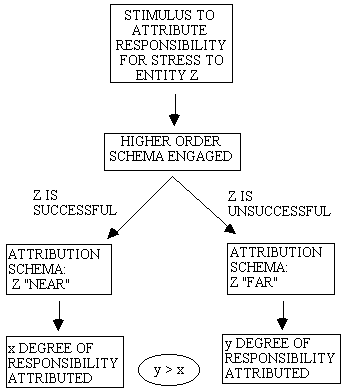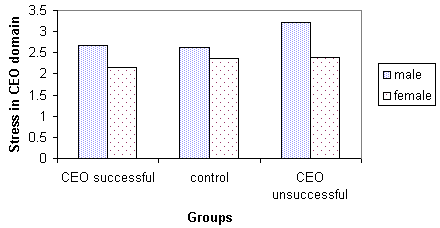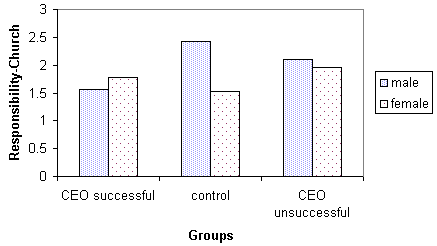
Figure 1: Schema model for attribution of responsibility for stress
This research is based on a theoretical model concerned with attribution of responsibility for occupational stress. Subjects were teachers in a Catholic education system (CEO). An integral component of the model is the psychological distance of a teacher from domains to which responsibility or blame for occupational stress can be ascribed. An experiment which employed a manipulation of perceived success or failure of the employing CEO is reported. A significant interaction of group membership by sex for level of stress associated with the CEO provides some evidence that males manipulated to perceive the CEO as unsuccessful reported greater stress associated with the CEO. A significant interaction of group membership by sex for responsibility for occupational stress attributed to the Church suggests that for these teachers the relationship between Church and employing Catholic education authority may have been complex. Differences between males and females in attribution of responsibility to self and to students are also reported.
The attribution of perceived causes of successes and failures has been a major preoccupation of Attribution Theory (Frieze, Moss and Olson 1991; Weiner, 1985). Occupational stress can be conceptually linked to "success" and "failure". Barone (1995) found that human service workers reported significantly less stress, when required to sign their names to a survey of work stress, than those who completed the form anonymously. For some individuals, "coping" with occupational stress may equate with personal success and "failing to cope", particularly when the distress is significant, with personal failure.
The causal analysis inherent in Attribution Theory may be considered adaptive in nature (Weiner, 1985), in as much as it may elaborate the relationship between the individual and environment. Moreover, as Wong (1991) points out, understanding a problem is likely to assist in the choice of appropriate coping behaviours. It can be argued that humans develop "person-in-situation" schemas (Lord and Foti, 1986). These are cognitive structures, pre-existing knowledge, which relate self and environment. It is proposed, in this study, that teachers develop attribution schemas which give meaning to stable dimensions of their occupational stress. It is not suggested that these attribution schemas are objectively accurate descriptions of "reality". Indeed in developing schemas, It should be noted that objective causal relationships may not be legitimately drawn from these attribution schemas.
In a series of studies involving teachers of the NSW Department of School Education, McCormick (1997a, 1997b), (McCormick and Shi, 1999), and McCormick and Solman (1992a, 1992b) found empirical support for the attribution-of-responsibility model of teacher stress in a large education system. This model proposes that teachers do not simply think of themselves as subsystems of their schools which are subsystems of the educational authority, and so on. Rather, these may be thought of as separate domains, at different conceptual distances from the individual teacher. Moreover, it was found that the greatest responsibility for stress was attributed to the most distant domain which contains the entities Government and Department of School Education. An explanation of this externalisation of responsibility for stress is provided by the phenomenon known as the self-serving or hedonic bias (Forsterling, 1988; Kashima and Triandis, 1986; Weiner, 1985). In simple terms, the latter suggests that individuals tend to accept responsibility for success and deny responsibility for failure. Although the general thrust of attribution theory lies with individuals seeking authentic, rational explanations, the hedonic bias may result in non-rational explanations.
"Stress as failure" and "conceptual distance" are central to the attribution-of-responsibility model. It is intended, in this study, to incorporate other established and empirically-supported phenomena. Namely, the "basking in reflected glory" and "cutting off reflected failure" phenomena (Cialdini, Borden, Thorne, Walker, Freeman, and Sloan, 1976; Cialdini and Richardson, 1980; Snyder, Lassegard and Ford, 1986). The latter phenomenon can readily be identified with the "tendency for people to publicize a connection with another person who has been successful" (Cialdini et al., 1976 p.366). Although initially concerned only with an individual's strategy of enhancing his or her image for an observer (Cialdini et al., 1976), this view was complemented when Snyder et al. (1986) suggested that "...cutting off reflected failure can be understood as an image-protection tactic: that is, the severing of associations with others who have failed, in the interest of avoiding a negative evaluation by others (and oneself)" (italics this author's emphasis, p. 383). That is, Snyder et al. (1986) proposed, and supported empirically, the view that there are two related but distinct phenomena; stronger evidence was found for the "cutting-off-reflected failure" process, than for the "basking-in-reflected glory" process. The results of the latter study can be used to extend the attribution-of-responsibility model. This is shown in a much simplified form, diagrammatically in Figure 1. Note that language used here, for the purpose of comparing distances, is only intended to communicate relative differences.

Figure 1: Schema model for attribution of responsibility for stress
It is proposed that stimulation of an individual, to attribute responsibility for occupational stress to a particular entity, engages a rich, higher order schema, containing lower order attribution schemas. Which attribution schema is selected will be affected by the individual's perception of the success or failure of that entity. If the entity is perceived to be successful, then it is located relatively near the individual, and a relatively low degree of responsibility is attributed. If perceived to be unsuccessful, then it is located relatively distant from the individual, and a relatively high degree of responsibility is attributed. For, example, if an individual is a member of a highly successful organisation, she or he feels close to that organisation, and so attributes less responsibility for occupational stress to the organisation. Moreover, as self-reported levels of stress are based on perceptions, one may predict that levels of stress reported are consistent with the attribution pattern.
The study reported here has been guided by the following hypotheses.
| H1: | Teachers who believe that an education authority to which they attribute responsibility for their occupational stress is successful will attribute significantly less responsibility to that education authority than teachers who believe that the education authority is a failure. |
| H2: | Teachers who believe that an education authority to which they attribute responsibility for their occupational stress is successful will report significantly less stress associated with that educational authority than teachers who believe that the education authority is a failure. |
Although the manipulation was clearly about perceived success, or failure for the CEO, other items and aspects were included, primarily for two purposes. First, it was considered desirable to test the proposition that the manipulation could have non-specific effects in domains unrelated to the CEO, hence negating the main thrust of the study. Second, it was considered that the actual purpose of the contrived text would be less readily discerned by participants if the questionnaire contained a broader, coherent range of items.
After the questionnaire was administered to all participants in a school, each teacher was individually debriefed and the nature of the contrived texts and the purpose of the experiment were discussed.
The five factors essentially are concerned with the extent of occupational stress experienced in domains whose organisation is consistent with the attribution-of-responsibility for stress model. That is, the domains have a conceptual distance from the self. The student domain is concerned with stress attributable to students and consists of items such as "difficulty in motivating students" and "having to deal with students who constantly misbehave". The factor school domain is concerned with the school as an organisation in which stress may occur because of a lack of support from the principal and peers and consists of items such as "lack of a supportive and friendly atmosphere" and "not being appreciated by the principal". The factor personal domain is related to stress from personal inadequacy exemplified by "feeling of not being suited to teaching" and "personal failings". CEO domain consists of items such as "the relationship the CEO has with its schools" and "unrealistic demands from the CEO". The factor external domain refers to aspects of the environment "beyond" the CEO. For example, "the conviction that the education system is getting worse" and "the government's education policies". Unweighted factor scores were generated for each of the factors. It is important to distinguish between these factors and the responsibility items. The factors reflect self-reported stress in domains at varying conceptual distances from the teacher, and measure perceived level of occupational stress. The responsibility items measure the degree of responsibility for occupational stress attributed to specific entities. So these constructs are related but distinct.
For most variables, there were no significant differences, and treatment group differences only occurred for the CEO domain and responsibility-Church, suggesting that there was no generic effect from the manipulation. Statistically significant differences are shown in Table 1.
| Dependent variables | Biographical variables | df | F |
| CEO domain | sex | 1 | 11.39*** |
| sex X group membership | 2 | 3.98** | |
| responsibility-Church | sex | 1 | 4.98* |
| sex X group membership | 2 | 2.21*** | |
| responsibility-self | sex | 1 | 5.81* |
| responsibility-students | sex | 1 | 4.02* |
| *p<.05 **p<.01 ***p<.001 | |||
Males reported significantly greater stress in the CEO domain (male mean=2.83, female mean=2.30). Figure 2 illustrates the significant sex X group membership interaction. Whilst there were no statistical differences between treatment groups for responsibility-CEO, perusal of the group means showed a trend in the anticipated direction. That is, the descending order of the degree of responsibility attributed was: CEO unsuccessful, control, CEO successful (2.79, 2.56, 2.50 respectively).

Figure 2: CEO domain means for males and females by group membership
There was a statistically significant difference between males and females (male mean=2.05, female mean=1.76) for responsibility-Church. However, again there was a sex X group membership interaction which is illustrated in Figure 3.
There were statistically significant differences between males and females for responsibility-self (male mean=2.79, female mean=3.31) and responsibility-students (male mean=2.78, female mean=3.15).

Figure 3: Responsibility-Church means for males and females by group membership
Hypothesis 1 was not supported, although, as has been noted, there was a trend evident. Hypothesis 2 was not directly supported, but qualified support was provided by the significant sex by CEO domain interaction. Two points are worth noting. First, Table 2 shows that although a trend was evident for females, it was clearer for males. Second, the perception that the CEO was an unsuccessful organisation may have been more salient for the CEO unsuccessful group than the CEO being successful was for the CEO successful group.
That the interaction of sex by group membership should be significant for responsibility-Church is explainable, in part, by the relationship of the Church and the CEO. Each CEO is diocese-based with a bishop wielding the ultimate authority. In a sense, a CEO may be a split personality, particularly for its Catholic teachers. Although there is typically a number of Catholic religious filling positions in a CEO and much of the activities of the CEO would be expected to be embedded in Catholic doctrine, a CEO is also an employing body and arguably a somewhat distant bureaucratic entity. Notwithstanding this, the mean scores of the males and females, particularly in the control group, are somewhat surprising. It is highly speculative, but, assuming that the control group is representative of the other groups before the manipulation, it is possible that these differences are able to be explained by the generally different ways which males and females in the treatment groups reacted to the contrived texts. Both males and females may, in most circumstances, distinguish the Church as an institution from the CEO. However, exposure to the contrived texts may have emphasised the Church's role in the CEO. This may have resulted in both males and females re-evaluating and perhaps clarifying the Church's responsibility for their stress. In terms of the attribution-of-responsibility for stress model, the males may have generally moved the Church closer to self and the females generally further away from self. However, the speculative nature of this explanation needs to be reinforced and further research is needed to test this proposition.
This study has provided some evidence, albeit inconclusive, that the reporting by these teachers of stress associated with an education authority, involves an attribution process with identifiable sex differences for internal and external attributions. Males generally externalised more than females. There is evidence that the perceived success or failure of an education authority interacting with the sex of the teacher played a part in the level of stress reported to be associated with the education authority.
Cialdini, R. B., Borden, R. J., Thorne, A. Walker, R. M. R., Freeman, S. and Sloan, L. R. (1976). Basking in reflected glory: Three (football) field studies. Journal of Personality and Social Psychology, 34, 366-375.
Cialdini, R. B. and Richardson, K. D. (1980). Two indirect tactics of image management: Basking and blasting, Journal of Personality and Social Psychology, 39, 406-415.
Di Salvo, V., Lubbers, C., Rossi, A. M. and Lewis, J. (1995). Unstructured perceptions of work-related stress: An exploratory qualitative study. In R. Crandall and P. L. Perrewe (Eds), Occupational Stress: A Handbook. Washington DC: Taylor & Francis, 39-50.
Dworkin, A. G., Haney, C. A., Dworkin, R. J. and Telschow, R. L. (1990). Stress and illness behaviour among urban public school teachers. Educational Administration Quarterly, 26, 60-72.
Feather, N. T. and Simon, J. G. (1975). Reactions to male and female success and failure in sex-linked occupations: Impressions of personality, causal attributions, and perceived likelihood of different consequences. Journal of Personality and Social Psychology, 31(1), 20-31.
Fletcher, B, and Payne, R. (1982). Levels of reported stressors and strains amongst schoolteachers: Some UK data. Educational Review, 34, 267-278.
Forsterling, F. (1988). Attribution Theory in Clinical Psychology. Chichester: Wiley.
Frieze, I. H. Moss, M. and Olson, J. E. (1991). Perceptions of success in work environments. In S. L. Zelen (Ed), New Models, New Extensions of Attribution Theory. NY: Springer-Verlag, 126-162.
Jaspers, J., Hewstone, M. and Fincham, F. (1983). Attribution theory and research: The state of the art. In J. Jaspers, F. Fincham and M. Hewstone (Eds), Attribution Theory and Research: Conceptual Development and Social Dimensions. London: Academic Press, 3-36.
Kashima, Y. and Triandis, H. C. (1986). The self-serving bias in attributions as a coping strategy. Journal of Cross-Cultural Psychology, 17, 83-97.
Kramer, R. M. (1994). The sinister attribution error: Paranoid cognition and collective distrust in organisations. Motivation and Emotion, 18, 199-228.
Kerlinger, F. N. and Pedhazur, E. J. (1973). Multiple Regression in Behavioral Research. NY: Holt Rinehart and Winston.
Kyriacou, C. and Pratt, J. (1985). Teacher stress and psychoneurotic symptoms. British Journal of Educational Psychology, 55, 61-64.
Laughlin, A. (1984). Teacher stress in an Australian setting: The role of biographical mediators. Educational Studies, 10, 7-21.
Levitt, M. (1995). Sexual identity and religious socialization. British Journal of Sociology, 46, 3, 529-536.
Loehlin, J. C. (1992). Latent Variable Models. Hilldale NJ Lawrence Erlbaum.
Lord, R. G. and Foti, R. J. (1986). Schema theories, information processing, and organizational behavior. In H. P. Sims, D. A. Gioa and Associates (Eds), The Thinking Organization. San Francisco: Jossey-Bass, 20-48.
McCormick, J. (1997a). An attribution model of teachers' occupational stress and job satisfaction in a large education system. Work & Stress, 11(1), 17-32.
McCormick, J. (1997b). Occupational stress of teachers: biographical differences in a large school system. Journal of Educational Administration, 35(1), 18-38.
McCormick, J. and Shi, G. (1999). Teachers' attributions of responsibility for their occupational stress in the People's Republic of China and Australia. British Journal of Educational Psychology, 69(3), 393-407.
McCormick, J. and Solman, R. (1992a). Teachers' attributions of responsibility for occupational stress and satisfaction: An organisational perspective. Educational Studies, 18, 201-222.
McCormick, J. and Solman, R. (1992b). The externalised nature of teachers' occupational stress and its association with job satisfaction.Work & Stress, 6, 33-44.
Milstein, M. and Farkas, J. (1988). The over-stated case of educator stress. The Journal of Educational Administration, 26, 232-249.
Pierce, C. M. B. and Molloy, G. N. (1990). Relations between school type, occupational stress, role perceptions and social support. Australian Journal of Education, 34, 330-338.
Selye, H. (1976). The Stress of Life. New York: McGraw-Hill.
Snyder, C. R., Lassegard, M. and Ford, C. E. (1986). Distancing after group success and failure: Basking in reflected glory and cutting off reflected failure. Journal of Personality and Social Psychology, 51, 382-388.
Weiner, B. (1979). A theory of motivation for some classroom experiences. Journal of Educational Psychology, 71(1), 3-25.
Weiner, B. (1985). An attributional theory of achievement motivation and emotion. Psychological Review, 92, 548-573.
Wong, P. T. P. (1991). Existential versus causal attributions: The social perceiver as philosopher. In S. L. Zelen (Ed), New Models, New Extensions of Attribution Theory. NY: Springer-Verlag, 84-125.
| Author: Dr John McCormick is Coordinator of Educational Administration in the School of Education at the University of New South Wales. His research interests include occupational stress and various other aspects of motivation. For example, leadership, organisational decision making and cross cultural differences in organisational behaviour in educational settings.
Please cite as: McCormick, J. (2000). Psychological distancing and teachers' attribution of responsibility for occupational stress in a Catholic education system. Issues in Educational Research, 10(1), 55-66. http://www.iier.org.au/iier10/mccormick.html |
© 2000 Issues in Educational Research
Last revision: 31 July 2001. URL: http://www.iier.org.au/iier10/mccormick.html
HTML: Clare McBeath, Curtin University [bigpond.com] and Roger Atkinson [rjatkinson@bigpond.com]
During the period 12 Mar 2001 to 30 July 2001 the previous URL for this article, http://cleo.murdoch.edu.edu.au/gen/iier/iier10/mccormick.html, recorded 226 accesses.